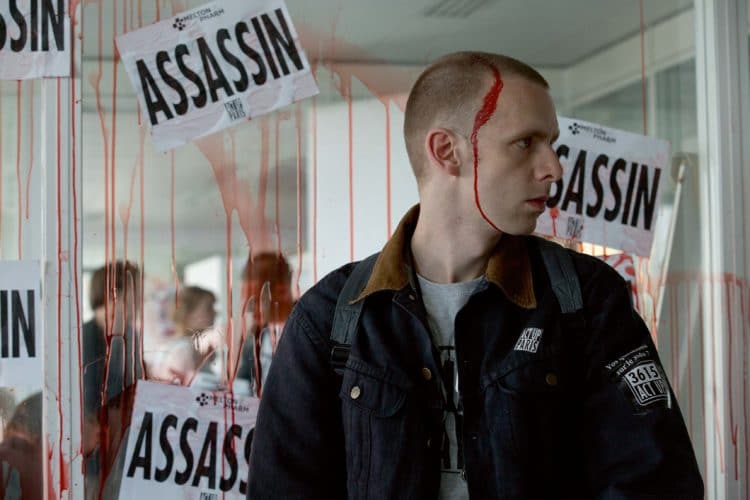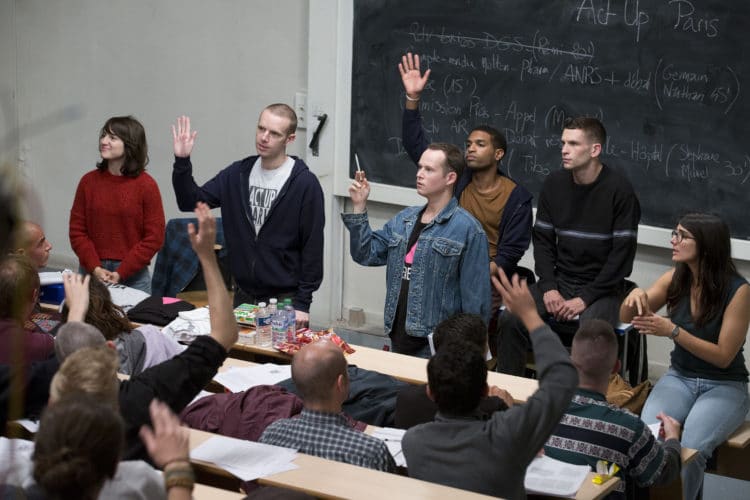There is more complexity to BPM‘s seemingly unremarkable style than meets the eye.
There are many remarkable things about BPM, Robin Campillo’s Queer Palm-winning historical ensemble about a radical activist group that worked to fight the AIDS epidemic in Paris in the early ’90s. For starters, there’s writer-editor-director Campillo’s canny, fluid editing, which splices trippy nightclub scenes with images of the group spreading the ashes of someone who died of AIDS patient over a banquet for health insurers. There are, too, the deeply-written characters, contradictory in the most human of ways; Arnaud Rebotini’s pulsing house and techno score (a nod at the film’s title); and stunningly naturalistic performances from the movie’s ensemble (out of which Nahuel Pérez Biscayart emerges as an extraordinary standout).
All of these elements work together to provide an authentic picture of the movement and the people who drove it – people who have, in the history of film, been treated with less attention, detail and empathy than their heroic efforts have earned. But underpinning BPM’s more obvious strengths is something that, on the surface, seems so decidedly unremarkable that it tends to be entirely neglected: its costume design.

Although BPM is set somewhere between twenty and thirty years ago, there are few clear indicators of its time period, and none visual. Allusions to contemporary events (such as the infected blood crisis of the ‘80s) and new sites of interest in AIDS treatment (the early development of protease inhibitor drugs) are the only elements that date the film, but most viewers are unlikely to be well-versed enough in the history of the AIDS epidemic to associate these subjects with the ‘90s. Similarly, even the constant presence of the ACT-UP group itself – with its signature logo, name and modus operandi – can only conjure up a link to that decade for those small audiences with prior knowledge of the group.
You only need to stretch as far as scrutinizing the above aspects of BPM to ascertain its period because of the absence of one thing: distinctly period-specific costume design. As one of the conspicuous visual components of a movie, clothes (or, more accurately, fashion) communicate a movie’s context to audiences with wordless, simple immediateness. Because of this, costume design performs many roles; it can, for instance, signal the specific historical context of a film, the passage of time within a movie, or even the enigmatic possibilities of the future. Take, for example, the conscious lack of denim in Spike Jonze’s Her. When juxtaposed against the clothes that Her’s world does share with ours, the absence of a fashion staple like denim stands out as a quietly symbolic decision intended to express the distinct avant-gardism of the movie’s period, thus tacitly signaling to audiences that it’s set during some point in the haze of the near-future.
But where Her removed and retained emblems of modern fashion in order to indicate the contrast between its imaginary time period and ours, BPM’s deft costume design (by Isabelle Pannetier) eliminates any element of difference between its historical context and today’s for the opposite reason.

On the face of it, Sean (Biscayart), Nathan (Arnaud Valois) and their ACT-UP comrades look just like millennials. Baseball caps, plaid flannel shirts, hoodies, tracksuits, backpacks, logo tees, Nike shoes and jackets (denim, bomber, harrington and leather biker) abound, while Sean’s Zayn-esque blonde-on-black highlighted hair and the shaved and cropped ‘dos of its young men and women draw further parallels between the movie’s ‘90s youth and today’s. Their styles range from athleisure to anti-fashion looks like normcore and Urban Outfitters-style grunge, and with camo colors, blue denim, and a Yeezy-style palette of oranges and browns dominating their attire, there is nothing separating BPM’s ‘90s characters from the young people of today.
The archival footage featured in the film helpfully demonstrates (to those of us who don’t have clear memories of ‘90s fashion) that real ACT-UP members dressed in much the same way as their fictional counterparts do. Conversely, however, these scenes from real French news footage also reveal the careful polishing of the movie’s ‘90s styles for BPM’s wardrobes. Not present in Campillo’s film, for instance, are the fluorescent green trousers and floor-length fur coats glimpsed in the news excerpts – items which haven’t yet made (or may never make) a fashion comeback. (Also absent are neon windbreakers, denim overalls, Oakleys, spiky hairdos, and other quintessentially ‘90s fashion motifs.)
While we can partly put the recognisability of BPM’s looks down to the recycling of fashion trends that happens every couple of decades or so, the conspicuous absences in its characters’ styles give away a cunning, conscious strategy in the movie’s costume design. In resisting definitively dating the film by including only those ’90s trends that today’s youth have adopted, Pannetier’s work ensures that everything about BPM is heightened: its joy, its grief, its political urgency.

Subconsciously or otherwise, we tend to interpret movie characters in relation to ourselves. Appearance has a lot to do with this: unless a period film is particularly well-equipped in other areas to make audiences overcome viewing its characters as two-dimensional relics from ancient eras, it’s harder for us to relate to historical characters whose appearances are worlds apart from our own. But because BPM’s characters present themselves in much the same way as many of us do today, that barrier lifts, and empathy, compassion, and a full, shared sense of humanity – things that have severely lacked in societies’ dominant response towards HIV/AIDS sufferers – follow. In seeing the movie’s characters sartorially reflected in ourselves and our peers, the emotions the film inspires can also flow away from the screen, into our acutely conscious knowledge of the persistence of HIV/AIDS and its accompanying traumas today.
What BPM’s costume design does is remind us of is our connection to the past; of its enduring continuities. This eye-opening practice of placing history side-by-side with the present is something that carries through in the movie in a wider sense, too. In a pivotal scene, young AIDS patient and ACT-UP member Jérémie (Ariel Borenstein) recounts the history of the moment that sparked the French Revolution of 1848 in voice-over, while documentary footage of a real ACT-UP stunt from the ‘90s plays under his words. He describes the “corpse parade” of 1848 – during which the bodies of gunned-down civilians were marched through the streets as a “call to arms” for France’s disenfranchised – before imparting his dying wish: that he, too, should have such a “political burial”. The significance of this moment lies in the fact that Jérémie, whose death is imminent, sees his own position reflected in that of his 19th-century forebears, who were moved to civil disobedience in much the same way ACT-UP is. That Jérémie crosses a century to draw a parallel between the revolutionaries’ efforts and his own reminds us of the power of civil action (proven across history), while it also draws attention to the continuities between his day and ours, with the obvious reference point being the ongoing fight against AIDS. What better way to echo the thematic work this layered scene does (in reminding us of the persisting links between past and present) than to draw our attention to the sharing of something as profoundly intimate as our personal appearance?
This is not to overstate the power of BPM’s costume design. Without the film’s dynamic dialogue, shrewd editing, naturalistic performances, semi-fly-on-the-wall cinematography and true-to-life narrative detail – the screenplay is largely based on Campillo’s own experiences as an ACT-UP member – there would be little for its characters’ familiar styles to reinforce. But it’s hard to deny that, if Sean, Nathan, Jérémie and the rest of ACT-UP looked like fossils from a bygone era, it would be difficult for the film to work its deep, humanistic magic on us. Because BPM‘s simultaneously 1990s- and 2010s-era costume design does such brilliant, near-undetectable work in underpinning the rest of the film’s efforts, it allows us to forget that the events depicted are supposed to have taken place thirty years in the past. Instantly, its characters are transported to us, giving us access to the full, immediate force of the film’s potent emotion and political weight.
The post More Than Just Clothes: The Ingenious Costume Design of ‘BPM’ appeared first on Film School Rejects.
0 comments:
Post a Comment